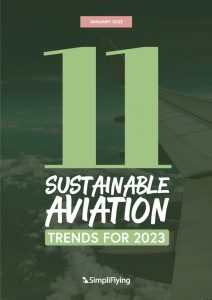NEWSLETTER
In Conversation: Holly Boyd-Boland, Virgin Atlantic


Over the next year expect to see more “intentional flying”, where both businesses and consumers make more conscious flight choices. Meanwhile there will be a much greater focus on the non CO2 impacts of air travel.
These are just some of the trends we’ve identified in our latest report, where we look at what the industry can expect in 2023. You can download it here.
One of the trends we’ve identified is an increase in direct action by protestors. There will be more instances like the protests in Munich and Berlin in December, which saw climate change activists glue themselves to the runway.
However we’ve also identified reasons for optimism as the industry looks towards net zero.
For example, expect to see further advances in battery technology, making electric regional aviation a reality and not a flight of fancy. And as our next story shows, the industry will deepen its involvement with carbon capture technologies.
As a subscriber, this report is available to you for free.
Also, take a look at some of our other recent reports and articles, including an examination of why climate change activists are targeting the industry, and a report we produced on greenwashing.
Here’s a really innovative example of how an airport is integrating carbon removals technology into its infrastructure.
The runway at Indianapolis International Airport is being made with carbon capturing concrete from Canadian company Carbon Cure, which was on our Summer 2022 carbon removals powerlist.
This is the first ever FAA approved design for an airfield project, where captured carbon dioxide will be used in the new concrete mix to prevent the CO2 from contributing to global warming.
Estimates say that the concrete used in the construction process will store the CO2 equivalent of planting 1.2 million trees.
This story is an excellent example of how carbon removals is about a lot more than just pumping carbonated water back into Icelandic rock.
For example, Air Company now makes SAF from captured CO2, after producing ‘Air Made’ vodka and perfume. And there are a number of companies, including NeoCarbon and Noya, which can retrofit the cooling towers you find on buildings into carbon capture units.
Fulcrum BioEnergy, Inc. receives funding from the Department for Transport (DfT), United Kingdom to develop Sustainable Aviation Fuel. (LinkedIn)
Does the world have enough lithium to move to electric vehicles? (Sustainability by numbers)
Seven in ten Brits don’t believe environmental claims made by companies are credible (Edie)
Brussels Airlines and Brussels Airport celebrate first day of the New Year with SAF Flight (FL360 Aero)
Ten ways Delta advanced the future of sustainable flying in 2023 (Delta News Hub)
How Sustainable Aviation Fuels can tackle aviation’s carbon footprint (World Economic Forum)
© 2022 SimpliFlying Pte. Ltd.